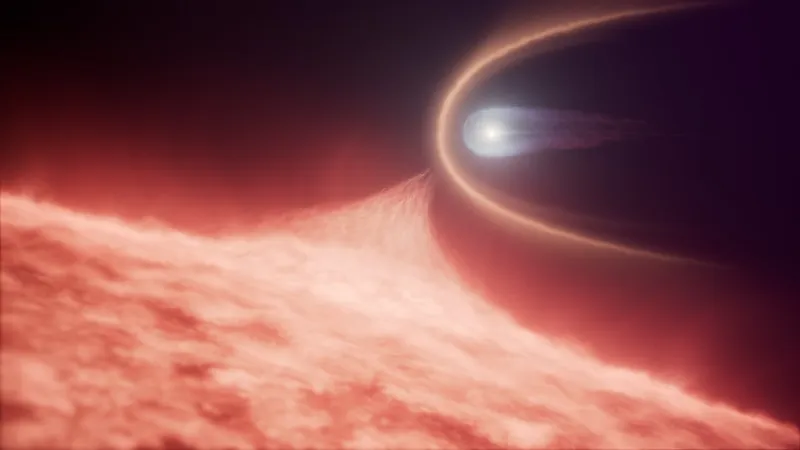
Astounding Discovery: Hubble Reveals a Unique Stellar Phenomenon!
2025-08-13
Author: John Tan
Hubble Makes a Groundbreaking Find
In a remarkable leap for astrophysics, an international team of astronomers has utilized the NASA/ESA Hubble Space Telescope to uncover an ultra-rare white dwarf. This stellar anomaly was born not from the natural evolution of a solitary star, but from the cataclysmic merger of a white dwarf with another star.
What is a White Dwarf?
A white dwarf represents the final fate of stars that lack the mass to explode as a supernova. This transformation begins when a star exhausts its hydrogen core, leading to a dramatic expulsion of its outer layers. What remains is a dense core, akin to Earth's size, evolving into a white dwarf, primarily made up of carbon and oxygen or oxygen and neon, depending on its original mass. Our Sun is on a trajectory to become one in about 5 billion years.
Ultra-Massive White Dwarfs: The Rarest of the Rare
While white dwarfs can theoretically reach up to 1.4 times the mass of the Sun, those exceeding this limit, termed ultra-massive white dwarfs, are incredibly scarce. They can form either from the evolution of a single high-mass star or through the spectacular fusion of two stars.
Focus on WD 0525+526: A Stellar Mystery
Hubble's Cosmic Origins Spectrograph has been instrumental in examining one such ultra-massive specimen: WD 0525+526, located a mere 128 light-years away and boasting a mass 20% greater than that of our Sun. While its visible light spectrum appeared typical for a white dwarf, the ultraviolet data unveiled an unexpected surprise: traces of carbon in its atmosphere.
Uncovering the Origins of Carbon
Typically, white dwarfs formed from single stars have atmospheres rich in hydrogen and helium, clouding the detection of carbon from their cores. However, the appearance of carbon signals a more chaotic origin. In scenarios involving mergers, collisions can obliterate the hydrogen and helium layers, exposing the carbon and allowing it to seep upwards into the spectrum.
A Discovery That Shatters Assumptions
Principal investigator Boris Gaensicke from the University of Warwick stated, "This discovery challenges our perceptions. What seemed to be an ordinary white dwarf turned out to have a complex history, akin to revealing layers of a person's past you never knew existed." This is the first known identification of a white dwarf born from a merger, based on its ultraviolet features.
WD 0525+526: A Stellar Anomaly Among Anomalies
WD 0525+526 is exceptionally noteworthy even among its peers, showcasing a scorching temperature of nearly 21,000 kelvins and a mass of 1.2 solar masses. Its extreme heat puzzled researchers, as convection typically mixes carbon into atmospheres for cooler white dwarfs. Instead, a subtler process called semi-convection was identified as the mechanism bringing carbon into its atmosphere—albeit in limited amounts.
The Future of White Dwarf Research
This astonishing revelation suggests that many other seemingly ‘normal’ white dwarfs may, in fact, be harboring hidden histories of cosmic collisions. The team is eager to delve deeper into how prevalent carbon white dwarfs are and to uncover the true nature of other stellar mergers within the white dwarf community, enhancing our understanding of stellar evolution and their potential paths to supernova explosions.
Published Findings and Further Exploration
The research paper detailing this groundbreaking discovery is published in Nature Astronomy, marking a significant milestone in the field of astronomical studies.
With Hubble's unparalleled capabilities, the team anticipates a wealth of new findings that could redefine our understanding of white dwarfs and the universe as a whole.





 Brasil (PT)
Brasil (PT)
 Canada (EN)
Canada (EN)
 Chile (ES)
Chile (ES)
 Česko (CS)
Česko (CS)
 대한민국 (KO)
대한민국 (KO)
 España (ES)
España (ES)
 France (FR)
France (FR)
 Hong Kong (EN)
Hong Kong (EN)
 Italia (IT)
Italia (IT)
 日本 (JA)
日本 (JA)
 Magyarország (HU)
Magyarország (HU)
 Norge (NO)
Norge (NO)
 Polska (PL)
Polska (PL)
 Schweiz (DE)
Schweiz (DE)
 Singapore (EN)
Singapore (EN)
 Sverige (SV)
Sverige (SV)
 Suomi (FI)
Suomi (FI)
 Türkiye (TR)
Türkiye (TR)
 الإمارات العربية المتحدة (AR)
الإمارات العربية المتحدة (AR)